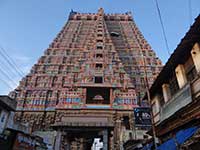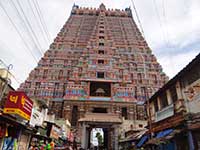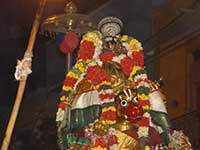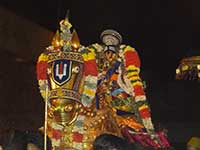Sri Renganathaswami Temple Srirangam
Srirangam Sri Ranganathasami Temple is also called as “Boologa Vaikuntam”. Even after many invasions by Moghal kings, this temple still stands without losing its beauty and fame. “Sri Ranganathar” is the main god of this temple and the “Ranganayaki” is the goddess. Srirangam is considered as the capital of Vaishnavas. To add to its pride this temple has the tallest temple tower in the World, the Rajagopuram (Main Tower) of this temple was built in 1983 and its 236ft tall. For “Vaikunta Yekaadesi’ pilgrims come from all over the world, it’s a 20 days celebration. It is most important pilgrim centre in the district is located on an island just 7km form Tiruchirappalli. Srirangam is the foremost of the eight self-manifested shrine (Swayam Vyakta Kshetras) of Lord Vishnu. It is also considered the first, foremost and the most important of the 108 main Vishnu temples (Divyadesams).
The temple complex is 156 acres in extent. It has seven prakaras or enclosures. These enclosures are formed by thick and huge rampart walls which run round the sanctum. There are 21 magnificent towers in all prakaras providing a unique sight to any visitor. This temple lies on an islet formed by the Twin Rivers Cauvery and Kollidam. The temple of Srirangam is the only one in India with seven enclosures, a sacred symbolic number which for present day Vaishnava believers represents either the seven centres of Yoga or a reference to the seven elements making up the human body, in the centre which dwells the soul.
Srirangam Festivals
Festivals in the Chitra Month
The New Moon Day in the Chitra Month, the Chitra Festival (Viruppan Thirunal) festivals for 10days. On the ninth day in the Revathi Nakshtra the Chitra Car Festival takes place. This is quite famous to all and large number of village people throng to the car festival.
Festivals in the Vaikasi Month
In this month Vasanthotsava is conducted for 9 days before the Vaisaka Full Moon day. On the ninth day Namperumal goes cut on Horse Vahana on the main Chitra Street.
Festivals in the Aani Month
In this month a Sahasra kalasa (1000 towel) Mahabisheka in done to the Moolavar as well as to the Utsavar. Same Sahasrakalasa Abisheka is done to Goddess. Sri Ranganachiyar on a Friday and to the Chakrat Alwar on a Saturday. On the following days a maha nivedan is conducted namely large quantity of rice is being distributed to one and all known as Thirupavadai Prasadam.
Festivals in the Aady Month
Aady 18th day of this month, Lord Sri Ranganatha goes to the Amma Mandapam. In the evening of this Adi 18th invaluable presents are made by the Lord to the Goddess Cauvery which is taken on the temple elephant t and thrown in the river Cauvery which is in full floods especially during this Adi month.
Festivals in the Avani Month
In this month Pavithrotsava is conducted to the Lord for nine days from the Sukla-Paksha (bright fortnight) Ekadasi day. To the negligence committed during all the days in the year in the Pujas, remedy is being sought for otherwise Aparadakshanpana is being sought for. On the day of Sri Jayanthi, Krishna Ashtami , Lord Ranganatha goes in procession the Sri Pndara Mantapam where Abisheka or Thirumanchanam is conducted while the Arayar Swamigal recites the Periya Alwar Thirumozhi about Sri Krishnavathara. In the night the Krishna Avatara takes place and the following morning Lord Sri Krishna goes about playing in the main Chitra Street distributing sacred gingely oil and sundal to all the devotees. Afternoon, Lord Sri Ranganatha with his consorts along with Sri Krishna goes to the Uri-Adi mantapam and after the procession is completed round the Chitra Streets, Uri-Adi takes place at the Southern entrance, South Gate near Patala Krishna Temple.
Festivals in the Puratasi Month
Dasara navarathri Utsava takes place in the Month at the Sri Ranga Nachiyar Sannathi. On the Vijaya Dasami day (10th day) Lord Sri Ranganatha goes over to the Kattu Alagia Singaperumal Koil in th east and in the evening Lord Sri Ranganatha comes out on the Horse Vahana and the farce of encounter-namely the killing of Vaniysura takes place.
Festivals in the Aipasi Month
In this month the Thirumanchana water to the Lord is taken from the river in a golden bowel on the back of the temple-elephant. The Vaisvarupa Dharsan is considered to be the important worshipping hour daily. Throughout this month only Golden vessels are used to the Lord for the Aradhana Purposes Dolotsava or the Unjal Utsava is the most glorious festival for this month. On the Deepavali day, God Sri Ranganatha takes the Thirumanchana and in the evening all the Alwars and Acharyas are presented with new cloths before the Lord enters the Sanctum Sanctorium.
Festivals in the Karthikai Month
On the full moon day of Krithigai Nakshatra Sri Ranganatha takes the Thirumanchanam and takes a precession in a special Thiruvasi decorated with Maru floweral petals and the Blaze-fire or Chokkappani is the important item of the day and in the end, the Lord after hearing the annual accounts area by the Kanakku Pillai enters the Sanctum Sanctorium on the hands of the Priest, instead of in the Tholukku Iniyan-which is called as Kali-thala seva. On this Thir Karthigai Day the temple Premises is illuminated with oil lamps.
Festivals in the Margali Month
The important of the month is all the more famous for the recital of Thiruppavai. The Thiruppalli Yezhuchi is the important programme to the Lord, which ie don very early in the morning. The Vaikunta Ekadasi festival falls in this month which lasts for 22 days. Commencing from the day of Thiru Nedum Thandakam to the Thiruvai Mozhi Chatumurai. On the 10th day of the festival is the Mohini Alangaramto the Lord to the Lord and on the 11th day. The Vaikunta Ekadasi is celebrated in the Thirma Mani Mantapam while the Lord wears the Ratna Angi, Only once on this Sacred Occasion. This festival called as Thriu Adayayana Utsavam. On the first 10days the Thirumozhi portion of the Divya Prabanda is chanted by the aryar swamigals in the ARjuna Mantapa and on the latter half of the festival is for the Thiruvai Mozhi Thirunal. On the last day, the Saint, Nam Alwar surrenders himself at lotus feet of the Lord, which function is called as “Alwar Thiruvadi Thozhuthal”.
Festivals in the Thai Month
The Thai or the Bhupathi Thirunal is conducted for 11 days in the bright for night and on 9th day falls the Thai car festival.
Festivals in the Masi Month
Teppotsava or the floating festival is conducted and on the 8th day. The floating is conducted in the temple tank to the west of the town. The following day is observed as Panda Kakshi day.
Festivals in the Panguni Month
In this month Adi Brahmotsava is conducted during the month in Sukla Paksha (bright fornight) after the observance on the Pnguni Uttra day the Lord enjoys the Chariot festival or the Goratha festival.
Additionally several utsavas are conducted on every ekadasi, Amavasai and Sankaramana days.
Mangalasasanam
Around 1300 years ago, during the Bhakthi movement, the Alwar saint poets of Tamilnadu sang verses(Mangalasasanam) in praise of Lord Vishnu. 108 of these Shrines and mythological abodes are collectively known as the Divyadesams shrines in the Vaishnava tradition.
Except Mathirakavi Alwar, all the other eleven Alwars have done Mangalasasanam in Srirangam. Periyalwar 31 Paasurams, Sri Andal – 10 Paasurams, Kulasekara Alwar – 31 Paasurams, Thirumangai Alwar – 72 Paasurams, Poigai Alwar -1 Paasurams, Boothathalwar – 4 Paasurams, Pei Alwar -2 Passurams, Nammalwar -11 Paasurams Total – 246 Paasurams.
Srirangam Seven Enclosure
The temple of srirangam is the only one in India with seven enclosures, a sacred symbolic number which for present day Vaishnava believers represents either the seven centers of Yoga, or a reference to the seven elements making up the human body, in the center of which dwells the soul.
First Enclosure
The visitor at last reaches the first enclosure to which, like the second, there is only one entry, by a gate in its southern part the Nazhikettan Gopura and on either side ahs images called Sanshanidhi and Padmanidhi, the conch and the lotus respectively, which are the attributes of Vishnu. To the southwest storerooms have been fitted up. Large mirrors have been placed in the corners in the corners to reflect the statue of the god when it issues from the sanctum.
In the northwest corner are the Yagasala and the Tondaiman Mandapa of which ceiling is decorated with paintings of figures. The eastern part contains two Mandapas Arjuna Mandapa and Kili Mandapa.
Second Enclosure
The second enclosure one must go through Southern Aryabhattal. The whole of this second enclosure, which is comparatively narrow, strikes the visitor by its pervading full light, since there is an almost broken series of mandapas. Towards the northeast corner are the kitchen premises, of the god here in the past were kept the milt and gifts of food, which were distributed, to pilgrims.
Third Enclosure
The third enclosure has the Karthikai gopura where leading the Garuda Mandapa, which consists of 14 rows and it, is the most beautiful Mandapa in the Temple. In the western wing kitches and rice storehouses are found. In the eastern part of this wing is the sacred tank (Chandrapushkarani), which has been hollowed out in the form of a circle flight of steps in the east and west. The eastern wing contains several isolated sanctuaries and mandapas.
Fourth Enclosure
In the Fourth court, non-Hindus may admire in its southern wing the Temple of Venugopala Krishnan, whose outside walls are decorated with very beautifl sculptures I high relief like young women playing the Zither (Veena) or with a parrot or putting the finishing touches (Tilaka) to their appearance before a looking glass. A climb to the terrace overhanging this temple affords a general view of the Temple of Srirangam.
This court also has a museum with highly interesting objects. Non-Hindus are also admitted to the eastern courtyard of this enclosure, which is dominated by the White Gopuram. In the south there exists the famous Sesharayar Mandapam. Opposite to this mandapa can be seen the Hall of Thousand Pillars, where in the Statues of God and Goddesses, Alwars and Acharyas are set out for the great annual festival of Vaikunta Ekadesi in December and January.
Fifth Enclosure
The fifth enclosure contains the shrine of Manavala Mamunigal in the Chola Style.
Sixth Enclosure
The sixth enclosure has four gopuras the eastern gopura is the most impressive of all on account of its size the inscriptions in Thirteenth Century characters. The processional cars are kept in this enclosure.
Seventh Enclosure
The gopuras of the seventh enclosure are unfinished. They are called Rayagopuram. The impressive dimensions of their bases prove that when finished, they would have risen to a height of at least 50m.
Srirangam Temple History
The History Behind
Many decades later, the whole of Srirangam was merged in a violent stand-storm. The Temple of Srirangam will all its suburbs were under the sand. Once, when a Chola king went out for hunting, he took shelter under the shade of a tree. The parrot which was perching on the tree began to chat, that the Sriranga Kshetra is buried under the sands. Hearing this, the Chola king began to discover the submerged town of Srirangam and renewed all the parts and suburbs of the town. The Chola king is called the Kilikanda Cholan (The king who was advised by the parrot).
Raja Rajendra Chola
When this king began to rule the Choladesa, then also he underwent many difficulties in protecting the town of Srirangam from its ruins. So far as time permitted him the King undertook the repairs of the temple and it’s Gopurams on the East and on the South.
Nanda Chola
After the death of Raja Rajendra Cholan, King Nanda Cholan of Dharma Varma Dynasty became very much devoted to Sri Ranganatha. He had no issues. One day he found a child in the lotus-tank of his capital, which was very beautiful. The king brought up the girl with all glory and happiness. She was called “Kamala Valli”. The King had the greatest pleasure of bringing up the girl Kamala Valli. Once Kamala went into the gardens with her mates to gather flowers. Instantly she took sight of a handsome youth on a horseback. He was the Lord of Srirangam “Sri Ranganatha” Himself. Kamala Valli was cast in a great spell of love with him. Her mind was stolen away by the Lord and she began to perform a severe tapas. The truth of the incident was made known to king. At once the king decided to give her in marriage to the princely youth and conducted the marriage. It is heard that as soon as the young couple entered the temple premises they were immured into a lustrous glory of Lord Sri Ranganatha immediately. The king built a mighty temple for them with all his wealth. This is the historical episode of Woraiyr. The king, Nanda Chola established a great Nanda Vana (garden for the Lord) and built of the Thirumamani Mantapam, the outer walls and the Gopuram. After his death, the temple was protected by his successors. As usual every year the Wedding Festival of Sri Kamala Valli was conducted. This festival takes place ;in the Panguni month every year when Lord Sri Ranganatha goes over to Woraiyur for the Thiru Kalyana Utsava of Kamalavalli Nachiyar at Woraiyur.
King Kulasekara
He was one of the most famous South Indian Kings. His daughter, Cherakula Valli was given in marriage to Lord Sri Ranganatha. To commemorate this, many mantapams are built in the third Prakaram. In this mantapam the Pavitra Utsavam of Lord Sri Ranganatha is conducted every year. The third of the seven Prakaras is so named after King Kulasekara known as “Kulasekaran Tiruchuttru”.
Aryabatal Entrance
Before 360 years a rich man form the land of Gods came here to worship Lord Sri Ranganatha with a great mass of wealth. But he was not given dharsna by the Lord. So, he stayed at the entrance itself with many watchmen to protect the temple of the Lord. Soon he was drawn to the favour of the Lord and was taken into the special devotion towards the Lord. Even now, this entrance is called the Arya Batal Entrance.
Parakalan (Thirumangai Alwar)
Before 445 years ago, Saint Parakala built 4 mantapams in the prakara of Rajamahendra and famous Garuda Mantapam. This Prakara is called the Ali Nandan Tiruchuttru (Thirumangai Alwar Prakara).
Vikarama Chola
King Vikarama Chola known as Akalangan (Man devoid of vices) built the Fifth Prakaram, three Gopurams and the sacred abode of Sri Ranga Nachiar and many mantapams in the Prakalan Prakaram. The abode of Lord Narasimha – Mettu Alagiasinga Perumal was built by this king.
Sri Sundara Pandian
This king embodied the sacred Vigrahas of Cherakulavalli and the Garuda Alwar (Peria Thiruvadi Nayanar). The king made the Ratna Angi Kavacha for the Utsava Moorthy, Sri Namperumal, and built the Golden Flag Staff of Dwaja Sthamba and made many gold and silver vessels for the use in temple. He also made many Vahanas for the processions with the wealth of 18 lakhs of rupees.
Vikraman
This king Vikrama built 4 Gopuram in the Parakalan Prakaram. The prakaram built by king Vikrama is known as Thiru Vikrama thiruchuttru. This is called the Uttara Street now. Lot of ruins were made to the temple by the invasion of the mohammaden reign. A musalman king took the Utsava Deity to his capital at Delhi. Due to the unwearied enterprises of the Srivaishanava Acharya, the stolen Utsave Moorthy was restored. It is understood that the daughter of Musalman king was very much devoted to Sriranganatha and she got herself immuned in the glorious lusture of the Divinity of Lord Sri Ranganatha. Equally as to the Lord daily pujas are performed to the musalman queen in the temple. Some of the Mohammaden principles are also being observed in the temple even now-a-days. Later on, the temple was brought upto a highest state by the kings of Vijayanagar. They attended to many of the ruins in the temple and rebuilt the destroyed parts. They made many valuable Abarnas to the God. The king Vijayaranga Chokanada Nayak built many mantapams. Even now, some of the gold and Silver made by them are kept in use.
Srirangam Sri Ranganatha Swami Temple Timings
Srirangam Sri Ranganathar Sannathi Timings |
|||
| Viswaroobam seva | 06.15 | to | 07.30 |
| Pooja time - No seva | 07.30 | to | 08.45 |
| Seva | 08.45 | to | 13.00 |
| Pooja time – No seva | 13.00 | to | 14.00 |
| Seva | 14.00 | to | 18.00 |
| Pooja time – No seva | 18.00 | to | 18.45 |
| Seva | 18.45 | to | 21.00 |
| Free seva | 20.00 | to | 21.00 |
No seva after 21.00 General Entrance – Free in all Seva time Special Entrance – Rs.20/- per head |
|||
Srirangam Sri Ranganachiar Sannathi Timings |
|||
| Viswaroobam Paid seva | 06.30 | to | 07.15 |
| Viswaroobam Free seva | 07.15 | to | 08.00 |
| Pooja time - No seva | 08.00 | to | 08.45 |
| Paid seva | 08.45 | to | 12.00 |
| Free seva | 12.00 | to | 13.00 |
| Pooja time – No seva | 13.00 | to | 15.00 |
| Free seva | 15.00 | to | 16.00 |
| Paid seva | 16.00 | to | 18.00 |
| Pooja time – No seva | 18.00 | to | 18.45 |
| Paid seva | 18.45 | to | 20.00 |
| Free seva | 20.00 | to | 21.00 |
| No seva after 21.00 | |||
| Timings are subject to change
in Festival days
Temple Guesthouses available near the main entrance of the temple. Cloakroom available near the Garuda mandabam. |
|||
Sthala Purana
Sri Ranganathaswami was worshiped by Brahma. He presented to Indra (King of Devas) and he presented to Surya (Sun God). And Surya vamsa Ikshavaku Kings (ancestors of Rama) worshiped Sri Ranganathaswami. At the time of Rama’s Pattabhisheka, Vibhishana obtained the Ranga Vimana (a special chariot like conveyance carried by Veda Murtis with Vishnu inside) from Rama as a gift. While carrying it to Sri Lanka Vibhishana halted at Srirangam. Contrary to the injunction he had received. Vibhishana placed it on the ground and it got rooted here.
 |
 |
 |
 |
 |
 |
 |
 |
 |
Quickly Find What You Are Looking For
